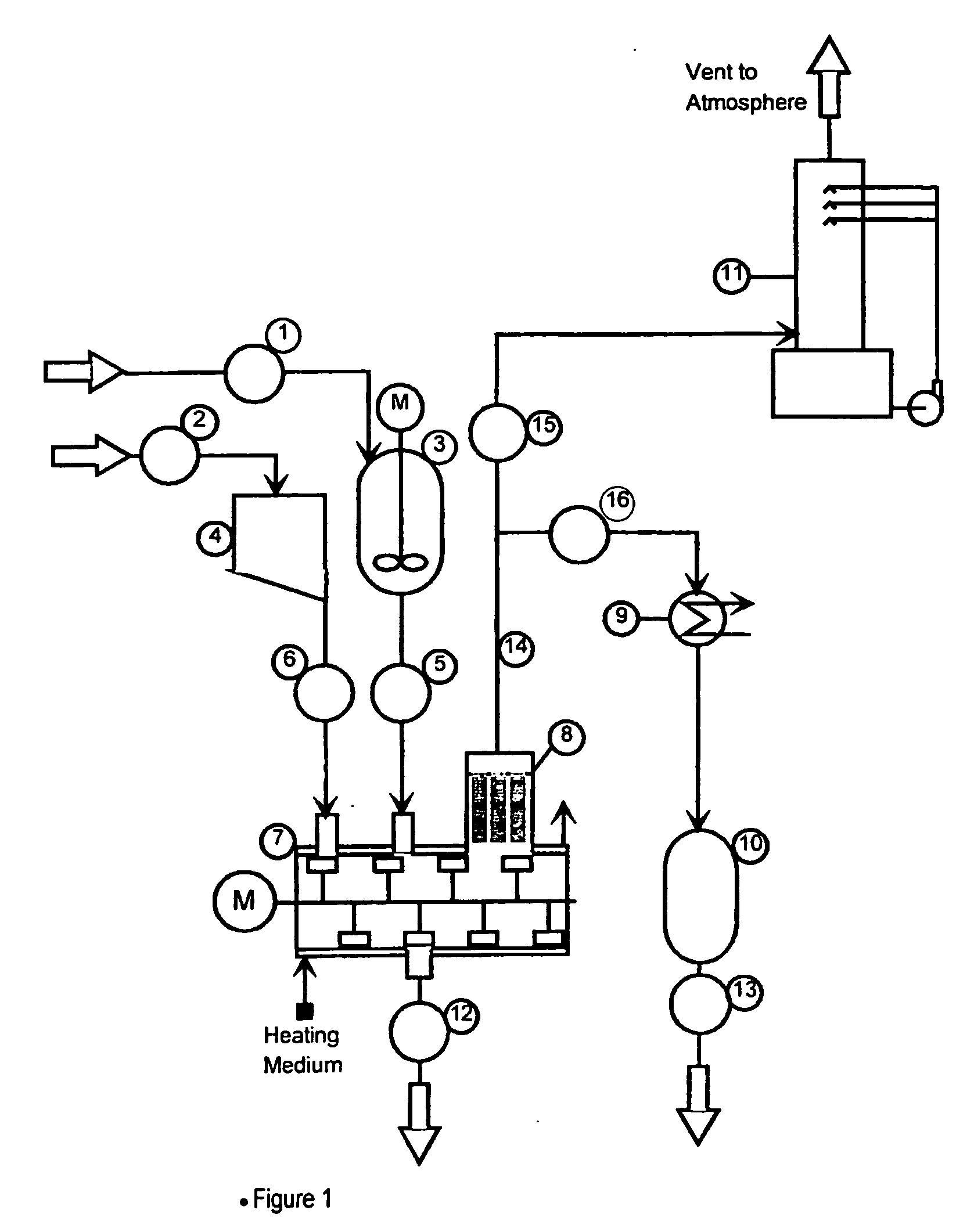Process for the treatment of waste metal chlorides
a technology for chloride and waste metal, applied in the field of waste metal chloride treatment, can solve the problems of corrosive hydrogen chloride gas or hydrochloric acid, slurry corrosion, and loss of significant economic penalty on the process, and achieve the effect of maximizing the recovery of valuable materials and low cos
- Summary
- Abstract
- Description
- Claims
- Application Information
AI Technical Summary
Benefits of technology
Problems solved by technology
Method used
Image
Examples
example 1
[0041] 1,160 Kg of a slurry consisting of 25% solid silicon and metal chlorides and 75% of a mixture of silicon tetrachloride and trichlorosilane was added to a horizontal paddle type drier constructed of Ferillium duplex stainless steel and having a processing volume of 3.24 m3. The drier was further equipped with an integral bag filter on the process vapor outlet to retain fine particles and a condenser was provided downstream of the bag filter to condense and collect volatilized chlorosilanes. 36 Kg of Cargill Microsized 66 finely ground sodium chloride was also added. At essentially atmospheric pressure, heat was applied to the jacket of the drier and the bulk of the chlorosilanes were boiled off and condensed into a receiver. When the batch temperature began to rise above 60° C. (the boiling point of silicon tetrachloride at process pressure), a fresh charge of 1,160 kg of slurry was made and the boiling continued. This fill, boil, fill sequence was repeated until a total of 4,...
example 2
[0042] A slurry consisting of 110 gram of solid residue from the hydrochlorination of silicon and 200 ml of silicon tetrachloride was placed in a 500 ml agitated flask that was fitted with several small TFE discs in the vapor path before a condenser. The slurry was gently heated to 80° C. while the silicon tetrachloride was evaporated. 18 gram of sodium sesquicarbonate powder was added to the flask and the temperature was increased to 130° C. After holding the temperature for two hours, the flask was cooled and the residual dry waste product had an indicated pH of 10.4. During the heating cycle, a yellow / white fume was collected on the TFE discs placed in the cooler portions of the apparatus. 160 mg of fume consisting of >90% aluminum chloride with a minor amount of iron chloride were collected on the TFE discs.
example 3
[0043] A slurry consisting of 110 gram of solid residue from the hydrochlorination of silicon (containing 5.4% Al, 2.6% Fe), 15 gram of finely ground sodium chloride and 200 ml of silicon tetrachloride was placed in a 500 ml agitated flask fitted with several small discs of TFE mounted in the vapor path below the condenser. The flask was heated slowly to evaporate the silicon tetrachloride. When the temperature reached 63° C., no more vapors were being removed. Then 30 g of Solvay T-200 finely ground trona (natural sodium sesquicarbonate) were added and the heating continued up to 160° C. After cooling, the residual solids were free flowing and odor free. The pH was 9.9. During the heating cycle, there was a markedly lower amount of white fume noticed. The amount of fume collected on the TFE discs was reduced to 8.5 mg of aluminum chloride (from 160 mg in Example 2).
PUM
| Property | Measurement | Unit |
|---|---|---|
| boiling point | aaaaa | aaaaa |
| temperature | aaaaa | aaaaa |
| temperature | aaaaa | aaaaa |
Abstract
Description
Claims
Application Information
 Login to View More
Login to View More - R&D
- Intellectual Property
- Life Sciences
- Materials
- Tech Scout
- Unparalleled Data Quality
- Higher Quality Content
- 60% Fewer Hallucinations
Browse by: Latest US Patents, China's latest patents, Technical Efficacy Thesaurus, Application Domain, Technology Topic, Popular Technical Reports.
© 2025 PatSnap. All rights reserved.Legal|Privacy policy|Modern Slavery Act Transparency Statement|Sitemap|About US| Contact US: help@patsnap.com

